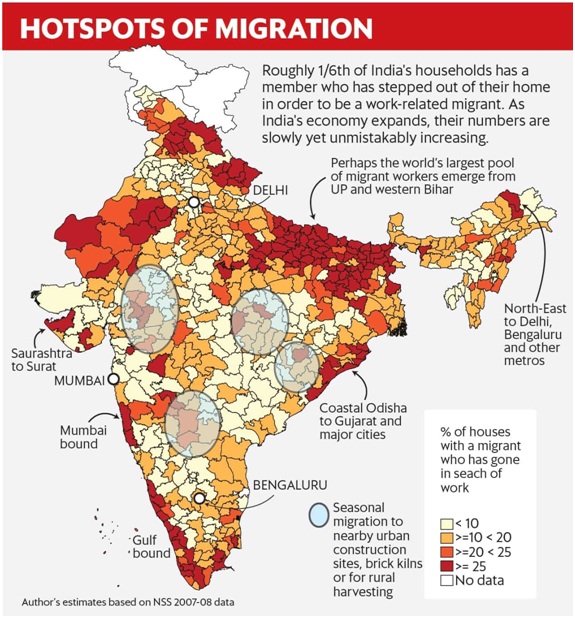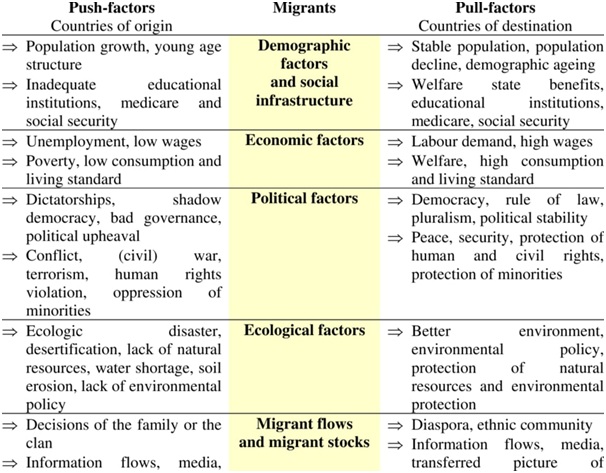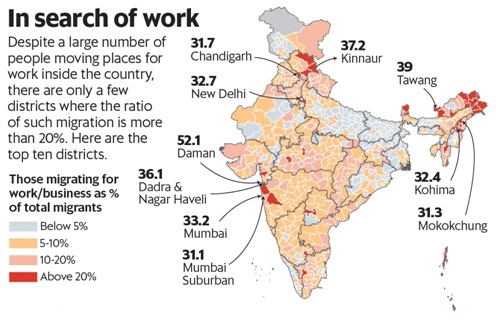India’s Migration Wave
In the seven decades since it became an independent country, India has seen and largely welcomed waves of migrants fleeing conflict in neighbouring nations. India in its 70 years as an independent nation-state has seen its fair share of migrant problems. And of course, it started with Partition itself.
Introduction
In the seven decades since it became an independent country, India has seen and largely welcomed waves of migrants fleeing conflict in neighbouring nations. India in its 70 years as an independent nation-state has seen its fair share of migrant problems. And of course, it started with Partition itself.
According to the International Migrant Stock 2019 report (released by the Population Division of the United Nations Department of Economic and Social Affairs), India with 17.5 million international migrants has emerged as the top source of international migrants, constituting 6.4% of world’s total migrant population.
Patterns of migration
Internal migrant flows can be classified on the basis of origin and destination. One kind of classification is:
-
- Rural-rural
- Rural-urban
- Urban-rural and
- Urban-urban
- As per the 2011 census, there were 21 crore rural-rural migrants which formed 54% of classifiable internal migration (the Census did not classify 5.3 crore people as originating from either rural or urban areas). Rural-urban and urban-urban movement accounted for around 8 crore migrants each. There were around 3 crore urban-rural migrants (7% of classifiable internal migration).
- Another way to classify migration is: (i) intra-state, and (ii) inter-state.
- In 2011, intra-state movement accounted for almost 88% of all internal migration (39.6 crore persons)
- There is variation across states in terms of inter-state migration flows. According to the 2011 Census, there were 5.4 crore inter-state migrants. As of 2011, Uttar Pradesh and Bihar were the largest source of inter-state migrants while Maharashtra and Delhi were the largest receiver states. Around 83 lakh residents of Uttar Pradesh and 63 lakh residents of Bihar had moved either temporarily or permanently to other states. Around 60 lakh people from across India had migrated to Maharashtra by 2011.

Factors
Migration is a global phenomenon caused not only by economic factors but many other factors like social, political, cultural, environmental, health, education are included under the broader classification of Push and Pull factors of migration
- Push Factor: Push factors are those that compel a person, due to different reasons, to leave a place of origin (out-migration) and migrate to some other place.
- Pull Factor: Pull factors indicate the factors which attract migrant (in-migration) to an area (destination)

Types
People move for many reasons, based on which types of human migration include internal migration (moving within a state, country, or continent) and external migration (moving to a different state, country, or continent).
Internal Migration
- Types: Internal migration in India is primarily of two types:
- Long term Migration, resulting in the relocation of an individual or household.
- Short term Migration, involving back and forth movement between a source and destination.
- Key Source States: Uttar Pradesh, Bihar, Rajasthan, Madhya Pradesh, Andhra Pradesh, Chhattisgarh.
- Key Destination States: Delhi, Maharashtra, Gujarat, Haryana, Punjab and Karnataka.
- Internal Migrants in India constitute a large population of 309 million internal migrants or 30 percent of the population (Census of India 2001).
- When a person is enumerated in the census at a different place than his / her place of birth, she/he is considered a migrant.
- Female Migration: Out of the total internal migrants, 70.7 percent are women (Census of India 2001) and marriage is one of the major reasons for female migration in both the rural and urban areas.
- Male Migration: Migration for employment-related reasons is one of the prominent reasons for male migration in both rural and urban areas.
- Employing Sectors: Migrants are mostly employed in subsectors like construction, domestic work, textile, brick-kilns, transportation, mines, quarries, and agriculture.
- Urbanization: Rates of urbanization influence rural-urban wage differences and an increase in the demand for labor in urban areas can push up urban wages and increase migration.

|
Some Facts and Figures
Issues faced by migrant labour
|
External Migration
- External migration in India can broadly be classified as:
- Emigration from India to various parts of the world.
- Immigration of people from different countries to India.
- Refugee Migration: There had also been a significant trend of an involuntary or forced immigration to India in the form of refugees.
|
International Migration and Global action
|
Causes
- Employment: Basic reasons for intrastate, interstate (migration from rural to urban areas, urban to urban areas) and external migration can be attributed to the search for better employment in industries, trade, transport, and services.
- Seasonal Migration: People seasonally migrate for employment in different areas and different industries.
- For example, significant numbers of people from drought-prone regions migrate seasonally to work in brickmaking, construction, tile factories, and agricultural work.
- Circular Migration or Repeat Migration is the temporary and usually repetitive movement of a migrant worker between home and host areas, typically for the purpose of employment.
- Education: Due to the lack of educational facilities at their place of residence, people migrate to urban areas in case of internal migration and other countries in the case of international migration for better academic opportunities. By 2020, India will become the world’s largest pool of young people, in contrast, there is a lack of opportunities for employment in India, this leads to the emigration of qualified people.
- Lack of security: Political disturbances and inter-ethnic conflicts are also one of the reasons for internal and external migration. There can also be forced displacement due to reasons like wars, and internal political instability.
- Marriage: Marriage is one important social factor for internal migration and in case of intra-state migrants majority of the migration is from one rural area to another, due to marriage in the case of females.
- Environmental and Disaster-Induced Factors: There are migrants who are forced to move from rural to urban areas or from one country to another as a result of an environmental disaster in the form of drought, floods, heat wavesetc. that might have destroyed their homes and farms.
Impact
1. Positive Impact
- Labour Demand and Supply: Migration fills gaps in demand for and supply of labour, efficiently allocates skilled labour, unskilled labour, and cheap labour.
- Economic Remittances: Economic well-being of migrants provides insurance against risks to households in the areas of origin, increases consumer expenditure and investment in health, education and assets formation.
- Skill Development: Migration enhances the knowledge and skills of migrants through exposure and interaction with the outside world.
- Quality of Life: Migration, enhances chances of employment and economic prosperity which in turn improves quality of life. The migrants also send extra income and remittance back home, thereby positively impacting their native place.
- Social Remittances: Migration helps to improve the social life of migrants, as they learn about new cultures, customs, and languages which helps to improve brotherhood among people and ensures greater equality and tolerance.
- Food and Nutrition Security: According to the 2018 State of Food and Agriculture report by Food and Agriculture Organisation (FAO), outmigration often leads to improved food and nutrition security for migrants.
- Demographic Advantage: As a result of outmigration, the population density of the place of origin is reduced and the birth rate decreases.
- Climate Change Adaptive Mechanism: Migration has also emerged as a possible adaptive mechanism in the context of climate change and the occurrence of extreme weather events like floods, droughts, and cyclones.
2. Negative Impact
- Demographic Profile: Emigration in large numbers can alter demographic profiles of communities, as most of the young men move out, leaving only the women and elderly to work on the land.
- Political Exclusion: Migrant workers are deprived of many opportunities to exercise their political rights like the right to vote.
- Population Explosion and the Influx of workers in the place of destination increases competition for the job, houses, school facilities etc. and a large population puts too much pressure on natural resources, amenities, and services.
- Illiterate and Under skilled Migrants are not only unfit for most jobs, because of a lack of basic knowledge and life skills but are also prone to the victimization of exploitation, trafficking, psychological abuse, and gender-based violence in the case of female migrants.
- Increased Slum: Mass Migration results into an increase in slum areas, compromising quality of infrastructure and life at the destination, which further translates into many other problems such as unhygienic conditions, crime, pollution, etc.
- Brain Drain: Source state suffers from the loss of human capital.
Challenges
- Inclusion and Integration of Migrants: Internal migration is not viewed positively in India and policies are often aimed at reducing internal migration, as a result, there is a lack of integration of migration with the process of development.
- Psychological and Emotional Stress: Any person migrating to a new country faces multiple challenges, from cultural adaptation and language barriers to homesickness and loneliness.
- Employment challenges: Foreign labour migrants often face unacceptable treatment from their employers. For instance, some labour migrants are paid below their contract wage and may be forced to work long hours and denied regular time off. Systems like reservation of jobs in many states and countries for the locals (visa barriers in US, Saudi Arabia’s Nitaqat law) pose as the main hurdle.
- Contract Wage System: The problems faced by migrants in destination countries range from contract violation, non-payment of salary, long working hours, and poor working conditions.
- Health Hazards: The poor and harsh living conditions coupled with difficult and risky working conditions, lack of information, and lack of medical health support also leads to several health problems of the migrants.
- Lack of Information: In spite of the challenges and problems faced by the migrants in the destination countries, low tendency to seek assistance from the diplomatic missions in the destination countries were also observed due to lack of knowledge, information about the role of diplomatic missions, trust and effectiveness to enhance access to justice.
- For internal migrants also there is the Inter-State Migrant Workmen Act (1979), enacted to prevent migrant workers from being exploited, but it is rarely invoked and the penalty is minimal.
- Exclusion from social benefits: The need to provide proof of address, ration cards, Voter IDs and Aadhaar cards, which is difficult due to the fluidity of their lives, deprive them from accessing welfare schemes and policies.
Way Forward
The Human Development Report by United Nation Development Programme (2009) highlights that migration is integral to the process of human development and it plays a very important role in achieving sustainable development goals, thereby preventing migration could even be counterproductive.
The United Nations Educational, Scientific and Cultural Organization has highlighted that the policies and programs facilitating the integration of migrants at the destination remain weak at best or non-existent and suggested the inclusion and integration of migrants in development. Hence India needs to formulate migration centric policies, strategies, and institutional mechanisms in order to ensure inclusive growth and development and reduce distress induced migration, thereby increasing India’s prospects for poverty reduction and achieving Sustainable Development Goals.
The government at Centre needs to provide amenities and social securities for the migrant population which is riddled with the issues of inadequate housing; low-paid, insecure or hazardous work; extreme vulnerability of women and children to trafficking and sex exploitation etc. For instance, schemes like Kerala government’s Aawaz health insurance scheme, ApnaGhar project -accommodation for migrant workers, Portable Rights- ensures the basic rights to workers in their respective home state, even as they labour in other states.

